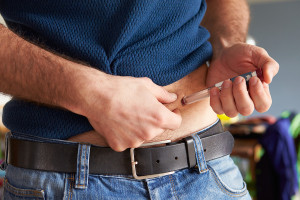Introduction
Hypoglycemia is the condition where blood sugar levels are below the normal range, below 50 mg/dL (= below 2.78 mmol/L) for men or below 45 mg/dL (=2.5 mmol/L for women).
The brain depends on blood sugar as its only fuel. In a patient with hypoglycemia, for whatever the reason for this condition is, unconsciousness can set in very quickly.
In severe cases of hypoglycemia, unless measures are taken to reverse this, the patient could die! Severe hypoglycemia is therefore considered a medical emergency. There is a multitude of reasons why hypoglycemia can develop. Briefly, there are conditions where too much insulin is circulating in the body resulting in hypoglycemia. Such conditions are listed in the table below and range from tumors in the pancreas and anti-diabetic drugs that stimulate the pancreas to produce more insulin, to a reaction to a sugar load about 1 to 3 hours after the meal in pre-conditioned people. This latter mechanism is the reason why about 30% of North Americans will come down with diabetes, if the high refined sugar and starch intake is not changed. Alcohol acts like a special drug as it specifically inhibits enzymes pathways in the liver that would normally provide alternative sugar output as a security measure to provide fuel (=sugar) for our brain.
Common causes of hypoglycemia
__________________________________________________________
alcoholic hypoglycemia : alcohol inhibits liver enzymes of glucose neogenesis
drug induced : diabetic medication, pentamidine (anti-parasitic drug), propranolol, quinidine, ASA in children
insulin overdose: requirements for insulin may decrease, so same dose of insulin causes hypoglycemia
island cell adenoma or cancer (pancreatic tumors) : insulin producing hormonal tumors
fasting hypoglycemia : particularly in individuals who have liver enzyme deficiencies
severe liver or kidney diseases : hypoglycemia from metabolic changes such as acidosis
reactive hypoglycemia : either inborn weakness or food induced; also prediabetic patients
__________________________________________________________
This “gluconeogenesis pathway” (=means”making blood sugar out of protein”), as physicians call this, is severely blocked in an alcoholic who may have fasted overnight and then starts a “breakfast” with an alcoholic drink. This person would have depleted the last liver glycogen stores by fasting overnight and can end up with a severe hypoglycemic coma due to the above mentioned lack of gluconeogenesis. Unless a physician is there to recognize the condition and immediately infuses high glucose concentrations intravenously, permanent brain damage or death can occur.
Other drugs such as propranolol, which is used as an anti-angina and antihypertensive drug, but also is useful for chronic migraine headaches as a preventative medication, can also partially block this metabolic liver pathway as explained above. Children are particularly sensitive to this blockage in the liver and in them even small amounts of ASA can cause hypoglycemia with seizures or different levels of unconsciousness. The younger the child (premature babies most sensitive), the more vulnerable they are. Certain anti-malaria drugs such as quinidine also block the gluconeogenesis pathway.
Signs and symptoms
With milder hypoglycemia the symptoms are also milder such as headaches, dizziness, anxiety and some weakness. With a moderate degree of hypoglycemia there would be in addition rapid heart beats, numbness of the fingertips and lips, difficulties concentrating, confusion and disturbed speech. A more severe case presents with even more severe symptoms such as abnormal behavior, blurred vision, extreme weakness, passing out, coma, seizures.
One of the key symptoms to watch out for are unexplained headaches that tend to be worse 2 to 3 hours after a meal and that improve when chocolates, candy, ice cream, bread or cookies are consumed. Until proven otherwise the physician should think about hypoglycemia.
What we can do to counter hypoglycemia
In this context it is important to mention that we all can do something about prevention of reactive hypoglycemia. Ref. 2 describes in detail a great number of healthy, very tasty meals that will not stimulate the reactive hyper-insulin response that the normal North American diet would otherwise induce in your system. The premise is very simple: cut out all bread, rice, potatoes and pasta and enjoy zone-type meals. This consists of plenty of vegetables, tossed salads, fruit, lean meat, fish, slow oats, soy products, lean cheese, turkey breast, lean 2% cottage cheese and is a low fat diet overall. If you are interested how to make that transition, you may want to read this chapter: “Health, nutrition and fitness”.
References
1. Goldman: Cecil Textbook of Medicine, 21st ed.,2000, W. B. Saunders Company
2. B. Sears: “The top 100 zone foods”. Regan Books, Harper Collins, 2001.
3. The Merck Manual, 7th edition, by M. H. Beers et al., Whitehouse Station, N.J., 1999. Chapter 176.
4. Noble: Textbook of Primary Care Medicine, 3rd ed.,2001, Mosby, Inc.
5. Goroll: Primary Care Medicine, 4th ed.,2000, Lippincott Williams & Wilkins
6.Rosen: Emergency Medicine: Concepts and Clinical Practice, 4th ed., 1998, Mosby-Year Book, Inc.
7. Ruddy: Kelley’s Textbook of Rheumatology, 6th ed.,2001, W. B. Saunders Company
8. Ferri: Ferri’s Clinical Advisor: Instant Diagnosis and Treatment, 2004 ed., Copyright © 2004 Mosby, Inc.
9. Rakel: Conn’s Current Therapy 2004, 56th ed., Copyright © 2004 Elsevier







